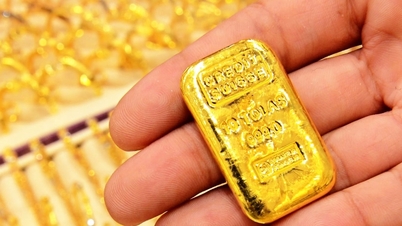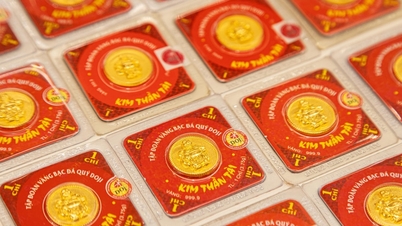Gold price today, February 17, 2025 is forecasted to decrease in the short term after the recent strong increase. Domestic gold price leaves the 91 million VND/tael mark.
At the opening of the trading session last week (February 10), SJC's 9999 gold price was listed at VND87.3-90.3 million/tael (buy - sell). Doji listed the price of 9999 gold rings at VND88-90 million/tael (buy - sell). SJC announced the price of gold rings of type 1-5 at only VND87.3-90 million/tael (buy - sell). After that, the domestic gold price increased following the world market, SJC gold jumped to VND91.3 million/tael.
On February 11, domestic gold prices skyrocketed, with SJC gold bars increasing by nearly VND2 million per tael. Domestic gold prices then fell across the board, losing the VND91 million per tael mark.
After the decrease on February 12, domestic gold prices rebounded on February 13. The price of SJC gold bars and gold rings increased by 1 million VND/tael, soaring to nearly 91 million VND/tael.
On February 14, the domestic price of SJC gold rings and bars continued to increase by nearly 1 million VND, to 91.3 million VND (selling). The buying price of SJC and rings is the same.
On February 15, domestic gold prices fell. At the end of the week, SJC gold bar prices closed at VND87.3-90.3 million/tael (buy - sell). SJC gold ring prices of 1-5 chi were listed at VND87.3-90.1 million/tael (buy - sell). Doji's 9999 gold ring price closed at VND88.3-90.3 million/tael.
Weekly, SJC gold bar price remained unchanged, SJC gold ring price increased by 100 thousand VND/tael. Doji gold ring price increased by 300 thousand VND/tael.
Last week, domestic gold prices had some "strange" developments when for a period of time, the price of SJC gold bars and gold rings, for the first time in many years, was lower than the converted world gold price.
The world spot gold price closed the trading week at $2,882/ounce. The gold futures price for April 2025 on the Comex New York floor was at $2,900/ounce.
The global gold market was affected by inflation data and concerns about the risk of a global trade war after US President Donald Trump announced plans to impose reciprocal tariffs on countries that tax imports from the US. By the end of last week, the pressure had eased.

Last week, US Federal Reserve Chairman Jerome Powell testified before Congress. The Fed Chairman said that there was no rush to cut interest rates because the economy was still growing and that inflation needed to be monitored before making any adjustments.
Shortly afterwards, Mr. Donald Trump called on the Fed to cut interest rates, in a new intervention in the US central bank's policy.
Meanwhile, Mr. Trump announced plans to reform trade policy, emphasizing the goal of imposing taxes on countries that have trade relations with the US.
The US president has postponed tariffs on goods imported from Mexico and Canada. Mr Trump has announced a 25% tariff on aluminum and steel imported into the US. Investors are debating the potential risks of tariffs on inflation and, in turn, monetary policy.
According to the latest annual report of the World Gold Council (WGC), gold prices have set a record 40 times in 2024, when global gold demand reached a historic peak of 4,974 tons. This trend continues into 2025.
Gold Price Forecast
Kitco News’ latest weekly gold survey shows that experts are less bullish on gold prices this week. Friday’s retail sales report is keeping gold prices down, said Bob Haberkorn, senior commodities broker at RJO Futures. Geopolitical factors, including news from Ukraine, are also weighing on gold prices.
Currently, a large amount of gold is being transferred from Europe to the US, to Comex vaults. Investors all want to focus on gold and expect it to trade above the $3,000/ounce mark.
According to Adam Button, director of currency strategy at Forexlive, $3,000 an ounce is the next target for gold. The possibility of a decline in gold prices. Investors are concerned about Mr. Trump's tariffs. He believes that gold prices could trade around $2,880 an ounce.
Source: https://vietnamnet.vn/gia-vang-hom-nay-17-2-2025-the-gioi-giam-vang-sjc-ra-sao-2371818.html






































































































Comment (0)